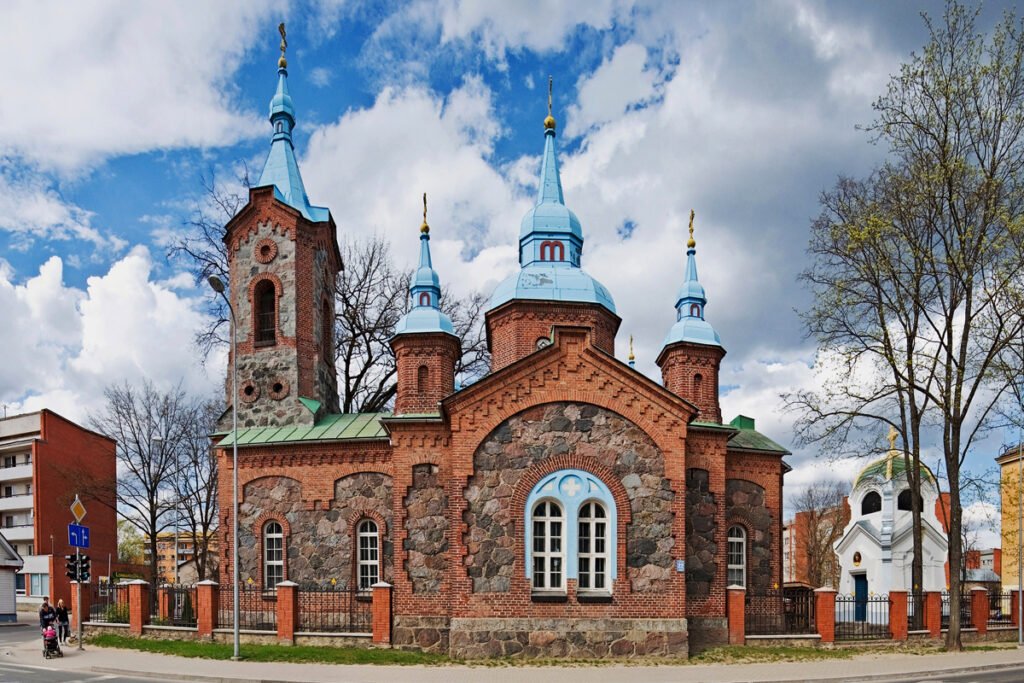Russian Orthodox Church of St. Alexandra – Bad Ems

Church of St. Aleksandry – the parish Orthodox church in Bad Ems, built in 1874–1876. Situated on the banks of the Lahn River. The establishment of the church was related to increasingly popular trips among the Russian aristocracy to health resorts in modern Germany, including Bad-Ems. The number of Russians who stayed in Bad-Ems in the summer months in the 1860s is estimated at several hundred people, and in the 1980s of the same century – at several thousand.
Russian Orthodox Church of All Saints

All Saints Church – an Orthodox church in Bad Homburg vor der Höhe, built in 1896–1899 according to the design of Leontij Benois. Parish temple in the Berlin and German Eparchy of the Russian Orthodox Church Outside Russia.
Saint Sergius of Radonezh Orthodox Church, Bad Kissingen,

Church of St. Sergius of Radonezh – an Orthodox church in Bad Kissingen, built in 1898–1901. It remains under the jurisdiction of the Russian Orthodox Church Outside Russia. The church in Bad Kissingen was inscribed on the UNESCO World Heritage List in 2021, when the work of the UNESCO World Heritage Committee resumed after the pandemic.
Russian Orthodox Church Of The Transfiguration. Baden-Baden

The church was built in 1882. A special contribution to its construction and maintenance was made by the Grand Duchess of Baden Maria Maximilianovna, nee Romanovskaya-Leuchtemberg, the granddaughter of Emperor Nicholas I, who in 1863 married Prince Wilhelm of Baden. Maria Maksimilianovna died in 1914 and was buried in a crypt under the altar of the Church of the Transfiguration. A glistening golden dome is the hallmark of this Byzantine-styled church, which should definitely be included on your tour of the town.
Greek Orthodox Church of Saints Constantine and Helen in Berlin

The Greek Orthodox Parish of the “Ascension of Christ” in Berlin is a district of the Greek Orthodox Metropolis of Germany, the Exarchate of Central Europe, which in turn is subject to the Ecumenical Patriarchate of Constantinople. In addition to the spiritual sanctuary, the Greek Orthodox Church of St. Constantine and Helena is a bustling center of cultural celebrations. Enriching the lives of its parishioners, the church becomes a place for gatherings and celebrations honoring the Hellenic heritage through music, dance and culinary delights.
Russian Orthodox Church of St. Mary Magdalene in Darmstadt

The Russian church on Mathildenhöhe was built by the last Russian Tsar Nicholas II and Tsarina Alexandra (Princess Alix of Hesse-Darmstadt) using private funds. The deeply religious ruling couple did not want to miss out on Russian Orthodox services during their family visits in Darmstadt. For this reason, the Tsar donated the funds to build the church on Mathildenhöhe, which was therefore private property of the Tsar’s family. The church was the first building to be built on Mathildenhöhe.
Russian Orthodox Church of St. Simeon in Dresden

The St. Simeon of the Wonderful Mountain Church is a Russian Orthodox church in the German city of Dresden. It was designed by Harald Julius von Bosse and Karl Weißbach and built from 1872 to 1874. It is dedicated to Simeon Stylites the Younger.

Russian Orthodox Church of St. Alexius in Leipzig

The Russian Memorial Church was erected in 1913 to commemorate the approximately 130,000 Russians who fought for Germany’s liberation against Napoleon in the Battle of the Nations in 1813. The church was dedicated on October 18, 1913. Since then, Leipzig’s orthodox religious community has met in the Russian Memorial Church.
Russian Orthodox Church of St. Alexander Nevsky in Potsdam

This Russian Orthodox memorial church was built in the Old Russian architectural style on the orders of King Frederick William III. It was designed by St. Petersburg court architect Vasily Petrovich Stasov with classicist additions by Karl Friedrich Schinkel, a manifesto reflecting the King’s desire to celebrate the close ties between Prussia and Russia. Construction work was carried out from 1826 to 1829.
The church stands on Kappellenberg hill not far from the Alexandrovka colony, which was also built especially for the Russian soldiers in Potsdam. Today both the colony and the church form part of the UNESCO World Heritage Site. The Alexander Nevsky Memorial Church is named after the Russian prince canonised in the 16th century. It is the oldest Russian Orthodox church building in Western Europe.
Russian Church of St. Nicholas in Stuttgart

The history of the Russian Orthodox community in Stuttgart begins on April 13, 1816, the day the Grand Duchess Catherine Pavlovna of Russia – later Queen of Württemberg and wife of King Wilhelm I – moved into the city. The parish received its first place of worship when the Russian Orthodox church was consecrated in 1824 over the burial place of the queen, who died in 1819, on Württemberg Hill.
The congregation unites many nationalities and is the oldest Russian Orthodox church in Germany still in existence today. It preserves the millennia-old spiritual and liturgical tradition of Orthodoxy.
Russian Orthodox Church of St. Mary Magdalene in Weimar


Church of St. Mary Magdalene – an Orthodox church located within the cemetery in Weimar. It is the seat of a parish under the Berlin and German Eparchy of the Russian Orthodox Church.
The Russian Orthodox chapel (St. Mary Magdalene) was built on Russian soil in honor of the Russian Czar’s daughter Maria Pavlovna. The chapel was inaugurated in 1862. Maria Pavlovna was the wife of the Grand Duke Carl Friedrich von Sachsen-Weimar (Saxe-Weimar). She lived and worked in Weimar from 1804 to 1859. Her tomb is in the chapel, next to the royal crypt.

Russian Orthodox Church of St. Elizabeth in Wiesbaden


St. Elizabeth’s Church is a notable Russian Orthodox church located in Wiesbaden. Built between 1847 and 1855, it was commissioned by Duke Adolf of Nassau in memory of his young wife, Grand Duchess Elizabeth Mikhailovna of Russia, who died during childbirth. The church’s distinctive golden domes and neo-Byzantine architecture make it a prominent landmark in Wiesbaden. Situated on the Neroberg Hill, it offers picturesque views of the city.
